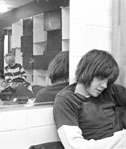
Comment
on this story
First Person: Transforming the Streets
One protester's reflections on Quebec
|
|
At 8:30 p.m., in the fresh darkness of early night, we cross the St. Lawrence River. Gary's already checked into a motel just outside town, somewhat to Hobbes' chagrin. Hobbes wants his father to get the full protest experience, which apparently includes not knowing where you're going to sleep until you get there. Gary's going to drop us off somewhere in downtown Quebec.
Quebec City is a strange place to hold a Summit of the Americas. It is one of the few French-speaking cities in the Western Hemisphere, and both in its architecture and its culture it feels European. With its long history of separatism, it is hardly a model for breaking down barriers. Along the main road into downtown, signs have been erected for the visiting diplomats. They say, "Welcome to the national capital." It is a deliberate political gesture by the territorial government; the capital of Canada is English-speaking Ottawa, 285 miles away.
Navigating the winding, narrow streets of downtown, we see sections of mesh steel fencing with concrete footers stacked along the sidewalks. They are pieces of "the fence," the 2.5-mile perimeter that the local and federal governments have decided to use to seal off the entire section of the city where the Summit is happening. During the Summit, no one will be able to enter or leave the security zone without authorization. But with the gathering two days off, the fence sections are just sitting there, waiting to be moved into place. The local press has dubbed the barrier "le mur du honte": the wall of shame.
Quebec City was founded on a cliff overlooking the river, for obvious reasons. You don't have to see the cannons still lining the ramparts to understand how easy the city was to defend against attack from either land or water. An 18th century wall still rings the "old town" at the top of the hill. It hasn't been used for actual security purposes in anyone's living memory, until now; the police have incorporated parts of it into the fence.
Down at the base of the cliff, along the city's inner harbor, we find a large white tent and a markethouse. This is the headquarters of the People's Summit, an "alternative" gathering of protest groups from across the Americas that's been holding seminars and forums all week on environmental, agricultural, social and industrial issues. There are dozens of tables piled with newsletters, press releases, manifestos, maps, and announcements of upcoming events. The crowd milling around the markethouse is older than I expected, mostly gray-haired and modestly dressed. Hobbes looks uncertain; this isn't exactly what he wanted. We ask a helpful man who looks to be in his 60s if there are any accommodations. He says he's heard that one of the nearby colleges is providing housing to "people like you, young people."
With smudgy photocopied maps in hand and heavy duffel bags on our backs, we head out into the dark city. It takes a good half-hour of tromping to get to the school the man indicated, and once we get there we find we've been misdirected—no housing. But a college-age guy working with a small group to assemble protest posters tells us we might find some help at the Horizon Centre, about eight blocks back the way we came. I'm exhausted and hungry and I can't remember the last time I reached 9:30 p.m. with literally no idea of where or when I would sleep that night. Hobbes seems excited.
His excitement turns to elation when we reach the Horizon Centre and find dozens of young people in jeans and surplus military jackets and hiking gear adorned with leftist political patches. "Oh yeah!" he says. We've found it—the check-in point for the younger, more radical protest community. And "community" it seems to be; within minutes of walking into the main hallway, we hear a woman's voice say, "Hobbes?" He turns and finds a short woman with close-cropped hair named Mary; she's a friend of a friend he met at the protests in Washington, D.C. last year. She and two companions have just arrived from Asheville. They're students at Warren Wilson College.
As Hobbes tries to secure a place to sleep, I realize there are two very different forms of protest going on in Quebec. The People's Summit, with its professionally designed brochures and website (peoplessummit.org) and facilities partly paid for by a grant from the Canadian government, is the "official" voice of dissent. It is organized and run by people who do this for a living—non-profit groups like Oxfam, labor organizations, international health groups. The Summit issues official press passes and provides a room full of telephones and computers for members of the mainstream media.
The Horizon Centre scene is something different; it's affiliated with less well-defined groups like Convergence des Luttes Anti-Capitalistes (Convergence of Anti-Capitalist Groups, universally referred to by its aggressive-sounding acronym CLAC) and the scrappy, activist IndyMedia collective (indymedia.org).


May 10, 2001 * Vol. 11, No. 19
© 2001 Metro Pulse
|





